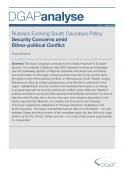This text offers an insider’s perspective on the Kremlin’s involvement in the South Caucasus, highlighting its security concerns and stressing that it does not pursue a universal approach to all of the post-Soviet conflict zones. While the Western political and expert community often assumes that territorial revisionism is a kind of idée fixe within Russia, this is far from the case. Each situation demands an individual response from Moscow, as it weighs and pursues its own interests. This in turn explains the unlikeliness of “Crimean situations” multiplying in the South Caucasus. The region undoubtedly harbors risks of confrontation – not only between Russia and the countries of the immediate region but also with such large powers as the US, the EU, Turkey, and Iran – but it also holds opportunities for cooperation.
Sergey Markedonov is an associate professor in the department of regional studies and foreign policy at the Russian State University for the Humanities. He was visiting fellow at the DGAP’s Robert Bosch Center in August–September 2016.
Introduction:
The tenuous political situation in the South Caucasus has been pushed off the news agenda by the crises in Syria and eastern Ukraine. But despite the shift of attention of diplomats, this region is still of strategic importance. As American scholar Daniel Treisman noted of the fast evolving crisis in Ukraine, by “annexing a neighboring country’s territory by force, [Russian President Vladimir] Putin overturned in a single stroke the assumptions on which the post-Cold-War European order had rested." Many are now asking whether the Kremlin is open to taking a similar approach in the South Caucasus, a region full of ethno-political conflicts and contradictions.
The renewal of fighting in early April 2016 between Armenians and Azerbaijanis in Nagorno-Karabakh ushered in a new period of uncertainty and confrontation for the South Caucasus. A challenge to the status quo was not completely unexpected. There had been more frequent violent incidents along the Nagorno-Karabakh Line of Contact as well as at the internationally recognized Armenia-Azerbaijan border, but April saw the worst fighting since the cease-fire of May 12, 1994.
The violence we saw in Nagorno-Karabakh in 2016 may recur at any time. The conflict zone has no peacekeepers and only a small number of OSCE observers, and the 1994 cease-fire has lasted thus far thanks only to a tenuous balance of forces, which may change in the future. Both the Armenian and Azerbaijani governments still insist that their maximum demands for resolving the conflict be met, while the three OSCE Minsk Group (OSCE MG) co-chairs mediating the conflict – France, Russia, and the United States – lack instruments to coerce the parties into making concessions.
Click on the box at right to read the full article as a pdf.
Contents
A Turbulent Region
Eurasian Integration vs. European Integration
The Special Significance of Russian Policy
Russia-Georgia: Viewing Strategic Differences against the Background of Tactical Shifts
Nagorno-Karabakh: Menacing Escalation
The Gains and Costs of Armenia’s Eurasian Integration
Azerbaijan: Partnership without Overrated Expectations
The Partly Recognized Republics: Strengthening Russian Influence and the Factors of Hidden Dissatisfaction
Conclusion

